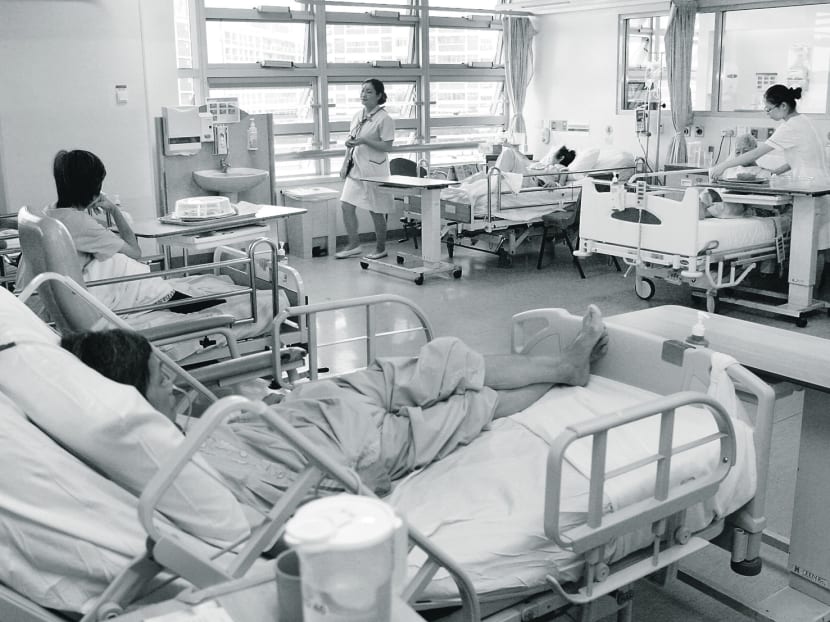Only one ‘right’ question to ask
A fundamental review of Singapore’s healthcare financing system is underway. In last week’s Committee of Supply debates, Health Minister Gan Kim Yong declared: “The review of our healthcare financing system will be extensive, and will involve fundamental shifts.”
A fundamental review of Singapore’s healthcare financing system is underway. In last week’s Committee of Supply debates, Health Minister Gan Kim Yong declared: “The review of our healthcare financing system will be extensive, and will involve fundamental shifts.”
He also announced that the Government will “take on a greater share of national spending, from the current one third to about 40 per cent and possibly even further”.
During the ensuing debates, there were calls to allow Medisave usage for screening and certain disease treatments, to increase coverage of MediShield and enable more Singaporeans to tap on Medifund.
Are these “fundamental shifts”?
I teach strategy in the local universities and one key insight is that in deciding strategies, always go back to an organisation’s mission and vision. If in doubt, “true north” is to be found by taking bearing from one’s mission.
What is the mission of the Health Ministry? It is “Championing a healthy nation with our people — To live well, live long and with peace of mind”. Since the emphasis is on healthcare financing, let’s focus on peace of mind.
Rather than labour over whether to tweak Medisave or expand MediShield, may I humbly suggest asking instead: What will give us peace of mind?
‘FREE’ IS not FREE
“Free healthcare” would be the glib retort, but Singaporeans are responsible enough to know that anything “free” leads to over-consumption and wastage.
In fact, the Singapore Democratic Party’s health plan, cleverly sub-titled Caring for All Singaporeans, calls for co-payments of 10 per cent, albeit with caps of S$2,000 per calendar year. Likewise, the Workers’ Party’s 2011 Manifesto agrees with the need for co-payments.
I think we can safely conclude there is unanimity across the political spectrum that “free healthcare” in the model of the original English National Health Service is not for Singapore.
The critical issue, then, in determining peace of mind is the level of co-payment by citizens — and that should be the rightful starting point for a fundamental review, which must focus on the patient.
To look first at Medisave, MediShield, Medifund and subsidies is akin to the tail wagging the dog. These are second-order questions which follow on after answering the first. Only one question is paramount: What is the appropriate level of co-payment?
This question can be further sharpened by income stratification or type of healthcare to conserve limited funds. Once we have determined what is the appropriate co-payment, the rest of the financing mechanisms can then come into play.
How can the rest of the medical bill be paid for? Whom should the Government subsidise more? Whom less? How much to come from Medisave? How much from MediShield? What about those with limited Medisave dollars? When does Medifund kick in?
30 YEARS A LONG TIME
Some would argue that such an approach would be reckless, putting at risk the country’s finances and everything built up over the last five decades. I would remind them of Thomas Jefferson’s words: “The purpose of government is to enable the people of a nation to live in safety and happiness. Government exists for the interests of the governed, not for the governors.”
I would further add that fears of wanton over-spending are overblown. No one is advocating free healthcare; the calls are for peace of mind and affordable healthcare.
It has been 30 years since Singapore introduced Medisave and the notion of individual responsibility. Interestingly, the British daily The Guardian, in the article “From user fees to universal healthcare — A 30-year journey”, described the Damascene 30-year-long conversion of one David de Ferranti, who in the 1980s was central to the World Bank’s efforts to introduce user fees into healthcare.
In 1985, he had written, “there appears to be considerable scope for having users bear a larger share of healthcare costs”. Fast forward to the present and Mr de Ferranti is the lead author for a prominent Lancet medical journal series (launched together with the Rockefeller Foundation and Results for Development Institute at last year’s United Nations General Assembly) advocating for universal health coverage.
Speaking to The Guardian, he mused: “The world has completely changed. Thirty years. Three decades. That’s a long time. Things change and arguments should change. And in the presence of more resources and the ability not just financially but administratively of countries to manage these programmes, which was again not there 30 years ago, it just now makes eminent sense and I have been outspoken in this — to move towards universal health coverage systems.”
Mr Gan should be applauded for initiating a fundamental review of Singapore’s healthcare financing framework. I hope think-tanks, academics, clinicians, citizens, all support him in asking and answering the right questions.
ABOUT THE AUTHOR:
Jeremy Lim has held senior executive positions in both the public and private healthcare sectors. He is writing a book on the Singapore health system.







